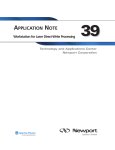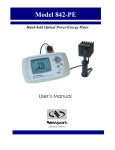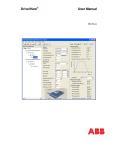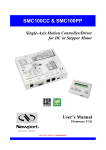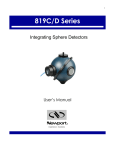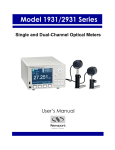Download Application Note 30
Transcript
APPLICATION NOTE Computer Controlled Variable Attenuator for Tunable Lasers 30 Technology and Applications Center Newport Corporation Computer-Controlled Variable Attenuator for Tunable Lasers This application note describes a closed loop, computercontrolled, variable attenuator (Figure 1) for the control of output power from a tunable laser. It is based on the combination of a 1/2 wave-plate and a polarizer. The algorithm used to control power operates in a closed loop with Proportional Integral Derivative (PID) feedback, compensating for slow changes in output power. Beam Sampler 1 Detector Beam Sampler 2 To Experiment From Laser Glan-Laser Polarizer Beam Dump Spectrometer Motorized Rotation Stage with 1/2 Wave-Plate Figure 2. Block diagram of the computer controlled attenuator. Figure 1. The computer-controlled variable attenuator. The setup consists of a detector, a single channel power meter, a Glan-laser polarizer, a 1/2 wave-plate mounted in a motorized rotation stage, two beam samplers, a spectrometer and a PC Principle of Operation The theory of operation for the computer-controlled variable attenuator is identical to that presented in Application Note 26 - Variable Attenuator for Lasers (www.newport.com/AppsNote26). It is based on Malus’s law. The intensity, I, of linearly polarized light that passes through the polarizer is given by I = I o cos 2 θ (1) where Io is the input intensity and θ is the angle between the beam’s initial direction of polarization and the axis of the polarizer. Rotation of a 1/2 wave-plate mounted in a rotational stage allows for continuous rotation of the polarization direction of the linearly polarized light. Thus, combined with a polarizer, it provides variable attenuation according to (1). Rotation of the wave-plate by an angle of ϕ results in a polarization rotation by an angle of 2 ϕ, thus the intensity at the output of the attenuator is given by, I = I o cos 2 2ϕ For the manual variable attenuator, the power is measured directly at the output of the attenuator for each wavelength and set accordingly by rotating the 1/2 wave-plate. In contrast, the computer-controlled closed loop attenuator sets and maintains the power by positioning the 1/2 wave-plate based on a feedback signal from a photo-detector. The photodetector can exhibit a strong dependence on wavelength (www.newport.com/818Series). This chromaticity becomes significant when the tuning range is large. Consequently, a spectrometer is incorporated into the setup, which provides real-time information about the laser’s wavelength, thus taking advantage of the photo-detector’s precise wavelength calibration. This is especially important when the laser power needs to be held constant while scanning wavelength. Depending on the choice of components, the attenuator is suitable for laser wavelengths ranging from 400 nm to 1100 nm, and average powers from 1 nW up to 20 Watts (500 Watts/cm2 damage threshold). This device is capable of attenuating light by a factor of 1000 while still maintaining an error of less than 10%. The algorithm used to control power operates in a closed loop with PID feedback, compensating for slow changes in output power within the bandwidth of the device (> 500 ms). Prior to the wave-plate, a fraction (1%-10% depending on the incoming polarization) of the beam is picked off by the first beam sampler and sent to a spectrometer. The remainder of the beam travels through the 1/2 wave-plate and Glan-laser polarizer. The attenuated output from the polarizer passes through the second beam sampler where a fraction of the beam is directed towards the detector at an angle of 10º relative to the main beam. The rejected portion of the beam is sent to a beam dump. The overall losses of the attenuator depend strongly on the degree of polarization, as well as the polarization state. However, if the incoming beam is fairly well polarized in the P-plane, the overall losses are below 10%. (2) where ϕ is the azimuth of the /2 wave-plate. The full range of attenuation is realized over 45º of rotation. The block diagram for the attenuator is illustrated in Figure 2. 1 1 Figure 3 illustrates the flow of information within the automated variable attenuator. The red arrows depict the route of the laser through the various optical components as described above. The CPU acts as the “brain” of the system and plays the following role: 1. Determines the angle/phase of the 1/2 wave-plate relative to the polarizer. 2. Monitors the wavelength, λ, from minispectrometer and updates the power meter wavelength setting. 3. Monitors the power of the beam out of the attenuator via the power meter. 4. Determines the error between the output power and the requested power. 5. Minimizes this error using a PID algorithm, and updates the rotation stage to a new position, ϕ. Minispectrometer 4. Move the base-plate into the final position and secure it to the table using the clamps provided. 5. Temporarily arrange the wave-plate, polarizer, beam samplers, spectrometer assembly and detector as shown in Figure 4. Take care to ensure that the angle formed between the primary beam path and the beam path from the second beam sampler to the detector is approximately 10º. 6. Secure the detector and the spectrometer assembly to the base-plate and remove all other optics. 7. Turn on the laser and insert beam sampler 1 into the beam path (see Figure 4). 8. Using the tip/tilt, direct the reflected beam onto the fiber of the spectrometer assembly. Laser Fraction of Beam 3. Turn the base-plate right side up and position it underneath beam path. Verify that the center of the beam is approximately 46 mm above the top of the base-plate. 9. Insert the wave-plate and polarizer into the beam path. Adjust the position such that the beam passes through the center of the wave-plate. Secure the wave-plate. Beam Sampler λ ϕ Requested Power CPU Polarizer λ Signal Proportional to Total Power Power Meter 1/2 Wave-Plate Rotation Fraction of Beam Dump Beam Sampler Experiment Figure 3. Flow chart describing operation of the automated attenuator Assembling the Attenuator 10. Rotate the polarizer such that the transmitted light is minimized. Next, fine tune the angle of the polarizer relative to the beam path to further minimize transmission. Secure the polarizer. Rotate the polarizer such that the tick marks lie in the horizontal plane (P-polarization relative to beam sampler 2). 11. Insert beam sampler 2 into the beam path. Use the tip/tilt to direct the reflection of the uncoated surface onto the face of the detector. Take care to ensure that the second reflection from the coated surface is not incident on the detector. 12. Position Beam Dump to capture rejected beam. Secure to base-plate. WARNING-Radiation emitted by laser devices can be dangerous to the eyes and appropriate precautions must be taken when they are in use. Only individuals who are adequately trained in proper laser use and safety procedures should operate the laser devices described herein. The instructions provided in this note are intended for use with the Spectra-Physics Mai Tai® laser. For use with other lasers, the height of the device needs to be adjusted to correspond to the height of the beam. 1. Mount all optical components as shown in Appendix 1. 2. Attach three 2-inch pedestals as well as the SMC100CC controller to the underside of the base-plate. 2 Figure 4. Automated variable attenuator. The red line illustrates the beam path. The numbered optics correspond to: 1-beam sampler, 2-1/2 wave-plate and rotation stage, 3-Glan-laser polarizer, 4-beam sampler, 5-918D-UV-OD3 photo-detector and 6-mounted fiber connected to minispectrometer. It should be noted that there are many possible attenuator configurations. The configuration described above was chosen because it offers several advantages: 1. The output polarization can be either S or P depending on the orientation of the polarizer. 2. The power on target is directly sampled rather than calculated. Running the Software for the First Time Open the SMC Power Control software (available from Newport’s pre-sale support ((800) 222-4640). Upon opening the program, the Data screen is displayed (see Figure 5). Select the Parameters tab (see Figure 6). Under this tab are the control settings for this device, including the hardware addresses and the settings for the PID control. Initially, leave the PID settings to the default values. 3. The control algorithm makes no assumptions about the relationship between the wave-plate position and the power on target. Computer Configuration The following requirements are necessary to operate this software. The processor should be at least a Pentium 4 (or equivalent) with 512 MB of RAM. The hard drive should have at least 50 MB of storage space available and have LabVIEW Run-Time Engine 8.2 installed. The operating system tested with this device is Windows XP Professional Edition. Once the variable attenuator is aligned, connect the power meter to the computer through the USB port located on the rear of the power meter. Connect the motorized rotation stage to the SMC100CC controller. Connect the SMC100CC controller to the computer using the RS232 cable provided. Install the Power Meter, Minispectrometer, SMC100CC and the SMC Power Control software using the disks provided. Reboot the computer. Figure 5. SMC Power Control Data screen Run the SMC program from the Start Menu. Make sure the stage is properly configured and sent to the home position. Note the address settings in the Configuration Panel. Close the SMC100CC program. After successful completion of this step, a green LED should be illuminated on the SMC100CC controller. If it is not, the SMC100CC controller is not properly configured and the device will not function. If this is the case, consult the SMC100CC User’s Manual. Connect the Minispectrometer to the computer through the USB port. Make sure that the laser is on and the “sampled” beam is hitting the Minispectrometer fiber. Open the TraqPro software provided and acquire data. Make sure that the spectrometer is capable of “seeing” the laser light. If the laser saturates the spectrometer, insert a diffuser into the beam path or decrease the integration time until the laser no longer saturates the spectrometer. Figure 6: SMC Power Control Parameter window. Make sure that the hardware settings match the values displayed in the Device Manager. If they are different, update the values using the Reinitialize Key to the settings in the Device Manager. In the Windows Control Panel, open up the System window. Under the Hardware tab, select the Device Manager. Under the Ports tab, determine which ports are being used by the power meter and the SMC100CC. Make note of this. 3 Calibrating the Spectrometer Select the Spectrometer tab (see Figure 7). Initially, set the integration time to 50 ms and run the spectrometer. The graph displays intensity (counts) vs. pixel number. Wavelength is calculated from a calibration file, and displayed in the Data window (see Figure 5). Turn on the laser and observe the signal. If the spectrum is below the level of noise, increase the integration time. Note that increasing the integration time also decreases the bandwidth of this device, thus slowing down the operation of the attenuator. More likely, it will be the case that the spectrometer is saturated (more than 55000 counts). If this is the case, the integration time can be reduced; however, neutral density filters as well as diffusers (cosine correctors) can also be inserted into the beam path to reduce the amount of light incident on the spectrometer. If the laser is tunable, scan the laser across the tuning range and observe the spectrum. It is important that the spectrum be above the noise level at all wavelengths. Again, using a combination of the integration time along with the appropriate filters, make sure that the laser spectrum is above the level of the noise, but below saturation for the necessary wavelength range. Figure 7: SMC Power Control Spectrometer window. The SMC Power Control software comes preloaded with a wavelength vs. pixel calibration file. This calibration will suffice for power control applications since the accuracy of the device need only be on the order of a few nanometers. However, if the spectrometer is to be used quantitatively, it may be necessary to manually re-calibrate the spectrometer. If this is the case, collect the spectrum of the known source. Determine the pixel number of the peaks using the intensity vs. pixel graph. Select the Calibrate Spectrometer key (see Figure 7). A screen with two columns and a graph of pixel number vs. wavelength will appear (see Figure 8). Deselect 4 Figure 8: SMC Power Control Wavelength Calibration window. the default calibration and select the Overwrite button. In the columns provided, enter the calibration wavelengths along with the corresponding pixel numbers. Using the bar, select the order of the polynomial (1-5) needed to describe the data. The graph will display the updated calibration values along with the calibration curve. Ultra-precise calibration is not required with this spectrometer since the resolution is ~1nm. Figure 9: SMC Power Control Auto-Calibrate window. Calibrating the Wave-plate The heart of the variable attenuator is the 1/2 wave-plate. It is responsible for rotating the polarization of the light. It is not required that the wave-plate be mounted in the rotation stage in any specific way; instead, the program will recognize the angle/phase of the wheel through the auto-calibrate function. First, select the Auto-Calibrate tab from the main panel (see Figure 9). Enter the number of points to be used in the calibration. Twenty points is a good starting value; however, more points can be added depending on the required accuracy. Press the Start button. The rotation stage will progressively rotate over 90º. The graph displays intensity vs. wave-plate angle as the stage rotates. After the stage finishes rotating, a solid line will be displayed on the graph derived from the best fit to Equation 2. This curve is used to set the high and low position limits for the rotation stage as well as determine the parameters used to calculate the intensity of the laser prior to attenuation. Controlling the Power After the spectrometer and the wave-plate are calibrated, the power control is ready to run. Select the Data tab. Make sure that the Open Loop button is disabled and enter the desired power in the Requested Power control and select the Start Power Control button. The graph displays the requested power (red) and actual power (white). Typically, the white line tracks the red line within a few steps. If this is not the case, the PID controls may need to be adjusted. A reference for PID tuning can be found at http://www.controleng.com/article/CA307745.html. As mentioned earlier, the software runs in closed loop. This means that the 1/2 wave-plate is continuously dithering, which may adversely affect some experiments. If this is the case, the user has the option to open the loop by selecting the Open Loop button. When the Open Loop button is selected, all gains (proportional, integral and derivative) are set to zero, thus disabling any wheel movement. Deselecting the Open Control Loop button (see Figure 5) returns all of the gains to their previous values. The Power Control software will also attempt to correct slow fluctuations in laser output. Because of this, if the laser is blocked, the 1/2 wave-plate will compensate by moving into a position corresponding to maximum transmission. Unblocking the beam will then temporarily deliver full power on target until the wave-plate has time to respond. This may result in optical damage to components or a sample positioned after the attenuator. To prevent this, a safety feature is built into the PID loop. If the laser power fluctuates by more than a user specified percentage, the software automatically opens the loop. When this happens, the error is logged and the user can reset the loop by deselecting the Open Loop button. The default percentage setting is 50%, but this value is free for the user to modify under the Parameter tab. When operating at attenuation levels higher than 100 times, care must be taken to block the scattered light from the detectors. In this case, it is also recommended to turn the safety feature off (see Figure 6). Finally, it is possible for the user to request powers outside of the available range. If this happens, the 1/2 wave-plate will move to its limit and stop. The power indicator will flash red and an out-of-range error will be logged. It is not necessary to reset this error. Simply command the attenuator back into the appropriate range and the indicator will return to the normal color. Polarization Control As mentioned earlier, one of the advantages to this specific configuration of the variable attenuator is that the output polarization can be either horizontal or vertical depending on the orientation of the polarizer. Changing the polarization or the angle of the beam sampler after the polarizer will result in a slight systematic error in the output power. To compensate for this, the scaling factor in the parameter window can be altered. The default setting is 0.042 corresponding to a Fresnel reflection at 10º from a BK7 substrate at 800 nm, P-polarization. At this angle, the Fresnel reflection has minimal wavelength dependence, thus allowing the source to be wavelength tunable without a significant impact to the attenuator’s performance. However, if the angle or polarization state is significantly modified, the scaling factor must be altered to compensate for these modifications. Table 1 lists the scaling factor as a function of wavelength and angle for both S-(top) and P-(bottom) polarization. In general the output polarization can be set in any direction by adjusting the azimuth of the polarizer. The scaling factor should be adjusted accordingly. Table 1: Scaling factors at various wavelengths and angles. o 7 o 9 o 11 o 13 o 15 o S/P 5 700 nm 0.044 0.043 0.045 0.043 0.045 0.042 0.046 0.042 0.047 0.041 0.048 0.040 750 nm 0.044 0.043 0.045 0.043 0.045 0.042 0.046 0.042 0.047 0.041 0.048 0.040 800 nm 0.044 0.043 0.045 0.043 0.045 0.042 0.0 46 0.041 0.047 0.041 0.048 0.039 850 nm 0.044 0.043 0.044 0.043 0.045 0.042 0.046 0.041 0.047 0.040 0.048 0.039 900 nm 0.044 0.043 0.044 0.042 0.045 0.042 0.046 0.041 0.047 0.040 0.048 0.039 950 nm 0.044 0.043 0.044 0.042 0.045 0.042 0.046 0.041 0.046 0.040 0.048 0.039 1000 nm 0.044 0.043 0.044 0.042 0.045 0.042 0.045 0.041 0.046 0.040 0.047 0.039 Dynamic Range The dynamic range of the attenuator can be thought of as the difference between the maximum and minimum achievable powers. The stated dynamic range is 103; however, dynamic ranges as high as 105 have been demonstrated in our Technology and Applications Center. In order to achieve a dynamic range this high, two important factors must be taken into consideration: stray light incident on the reference 5 detector must be minimized and the incoming light must be highly polarized. If a higher dynamic range is required, it is necessary to include a second polarizer just before the attenuator. To shield the reference detector from stray light, place an iris attached to a tube directly in front of the detector. Status Log The SMC Power Control software logs all generated errors, time stamps them, and records the errors to file. The Status Log window (Figure 10) allows the user to monitor any generated errors while the program is operating. Figure 10: SMC Power Control Status Log window. Exiting the Program To exit the program, simply hold down the Quit button until the program closes. It is preferable to use the Quit button since all of the devices are properly closed when exiting the program this way. Repeatedly closing the program by other means may result in computer instability. 6 Appendix1: Pictures of Mounted Optics 1. Beam Sampler 2. Rotation Stage and 1/2 Wave-plate 3. 4. 5. 6. 7. Polarizer Beam Sampler Photo-detector Fiber connector to spectrometer Beam Dump 7 Newport Corporation Worldwide Headquarters 1791 Deere Avenue Irvine, CA 92606 (In U.S.): 800-222-6440 Tel: 949-863-3144 Fax: 949-253-1680 Email: [email protected] Visit Newport Online at: www.newport.com This Application Note has been prepared based on development activities and experiments conducted in Newport’s Technology and Applications Center and the results associated therewith. Actual results may vary based on laboratory environment and setup conditions, the type and condition of actual components and instruments used and user skills. Nothing contained in this Application Note shall constitute any representation or warranty by Newport, express or implied, regarding the information contained herein or the products or software described herein. Any and all representations, warranties and obligations of Newport with respect to its products and software shall be as set forth in Newport’s terms and conditions of sale in effect at the time of sale or license of such products or software. Newport shall not be liable for any costs, damages and expenses whatsoever (including, without limitation, incidental, special and consequential damages) resulting from any use of or reliance on the information contained herein, whether based on warranty, contract, tort or any other legal theory, and whether or not Newport has been advised of the possibility of such damages. Newport does not guarantee the availability of any products or software and reserves the right to discontinue or modify its products and software at any time. Users of the products or software described herein should refer to the User’s Manual and other documentation accompanying such products or software at the time of sale or license for more detailed information regarding the handling, operation and use of such products or software, including but not limited to important safety precautions. This Application Note shall not be copied, reproduced, distributed or published, in whole or in part, without the prior written consent of Newport Corporation. Copyright ©2007 Newport Corporation. All Rights Reserved. Newport Corporation, Irvine, California, has been certified compliant with ISO 9001 by the British Standards Institution. MM#90000090 DS-12065









